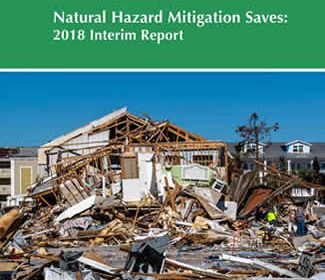A new National Institute of Building Sciences report highlights the significant savings realized from implementing mitigation strategies in terms of safety, property loss prevention, and day-to-day life disruption. The project team behind the Interim Report on the Value of Mitigation weighs the benefits of designing homes and buildings to meet the 2018 International Residential and International Building Codes versus the prior generation of codes reflecting 1990s-era practice and National Flood Insurance Program requirements.
Team members calculate a national benefit of $11 for every $1 invested in strategies aligning current IBC and IRC standards. Communities that consistently meet the latest editions of commonly adopted code requirements have supported 30,000 new construction materials industry jobs and spurred an approximate 0.3 percent increase in material consumption for each year of new construction abiding current codes over past practice.
|
|
| The report is posted at www.nibs.org |
Mitigation strategies the project team studied demonstrate that a) Incorporating at least one foot of freeboard into the elevation requirements to comply with the 2018 I-Codes saves $6 for every $1 invested in floor resistance; b) Complying with roofing and a variety of openings and connection detailing requirements in the 2018 I-Codes saves $10 for every $1 invested in hurricane wind load resistance; and, c) Designing new buildings to be stronger and stiffer per 2018 I-Code provisions saves $12 for every $1 invested in earthquake load resistance. The report finds these benefits carry over to all stakeholders—from developers, title holders, and lenders to tenants, owners, and communities.
Released last month during Building Innovation 2019: The NIBS Seventh Annual Conference in Washington, D.C., Interim Report on the Value of Mitigation is a compilation of the project team’s results to this point and includes findings from a 2017 update plus Natural Hazard Mitigation Saves: Utilities and Transportation Infrastructure, released in October 2018. As with preceding documents, the new report is an independent work funded with the support of public and private organizations interested in raising stakeholder knowledge of hazard mitigation benefits. In addition to the International Code Council, sponsors include the Department of Housing and Urban Development; Economic Development Administration; Federal Emergency Management Administration; American Institute of Architects; Insurance Institute for Business and Home Safety; and, National Fire Protection Association.
To vet the methodology used and ensure the study’s accuracy, the Institute received input from renowned experts in resilience across all hazard types, including academia, non-profits, government agencies and the private sector. Experts were engaged to conduct the analyses and additional experts were invited to peer-review the results. Over 100 subject matter experts participated in the development and review of the study methodologies and findings.
In its 2017 report, the project team looked at scenarios that focus on designing new buildings to exceed 2015 IBC and IRC provisions and meeting the 2015 International Wildland Urban Interface Code. The report released in October 2018 looked at case studies for utility and transportation infrastructure based on Economic Development Administration grants and California projects. In 2005, the Institute released its original mitigation report, the FEMA-funded Natural Hazard Mitigation Saves: An Independent Study to Assess the Future Savings from Mitigation Activities; it determined that the agency’s mitigation grants to have a 4:1 benefit-cost ratio. One of the report’s key findings, “For every $1 spent on mitigation, there is a $4 return of avoided losses in the future,” is frequently cited in policy circles.
